2005 CHEVROLET SILVERADO service
[x] Cancel search: servicePage 106 of 580

The theft-deterrent system will not activate if you lock
the doors with a key or use the manual door lock.
It activates only if you use a power door lock switch
with the door open, or with the remote keyless
entry transmitter. You should also remember that you
can start your vehicle with the correct ignition key if the
alarm has been set off.
Here is how to avoid setting off the alarm by accident:
If you do not want to activate the theft-deterrent
system, the vehicle should be locked with the
door key after the doors are closed.
Always unlock a door with the remote keyless entry
transmitter. Unlocking a door any other way will set
off the alarm if the system has been armed.
If you set off the alarm by accident, you can turn off the
alarm by pressing unlock on the remote keyless
entry transmitter. You can also turn off the alarm by
placing the key in the ignition and turning it to START.
Testing the Alarm
The alarm can be tested by following these steps:
1. From inside the vehicle, lower the driver’s window
and open the driver’s door.
2. Activate the system by locking the doors with the
power door lock switch while the door is open, or
with the remote keyless entry transmitter.
3. Get out of the vehicle, close the door and wait for
the security light to go out.
4. Then reach in through the window, unlock the door
with the manual door lock and open the door.
This should set off the alarm.
If the alarm does not sound when it should, but the
vehicle’s headlamps �ash, check to see if the horn
works. The horn fuse may be blown. To replace the
fuse, seeFuses and Circuit Breakers on page 5-123.
If the alarm does not sound or the vehicle’s headlamps
do not �ash, see your dealer for service.
2-20
Page 107 of 580
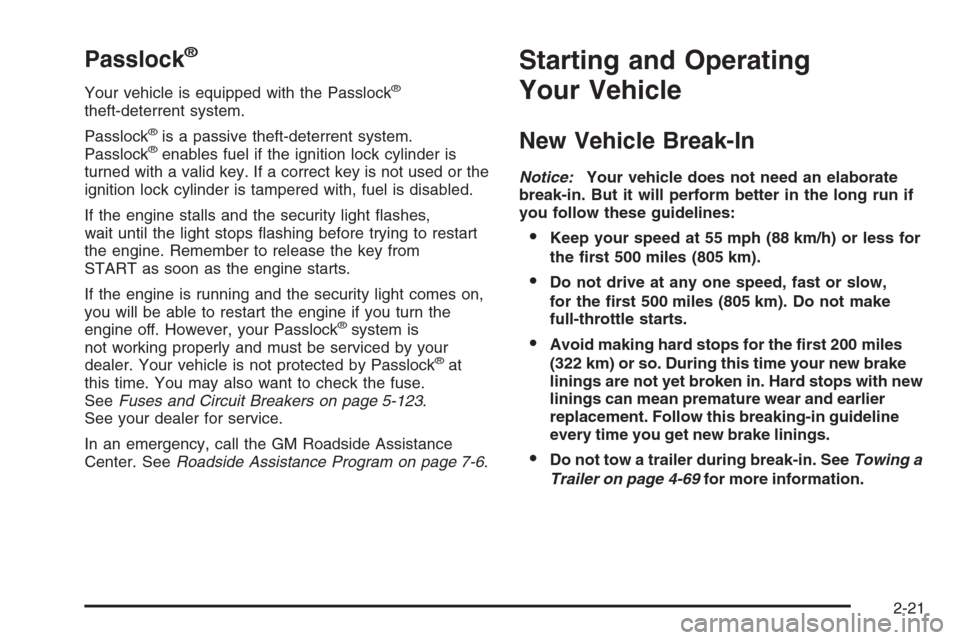
Passlock®
Your vehicle is equipped with the Passlock®
theft-deterrent system.
Passlock
®is a passive theft-deterrent system.
Passlock®enables fuel if the ignition lock cylinder is
turned with a valid key. If a correct key is not used or the
ignition lock cylinder is tampered with, fuel is disabled.
If the engine stalls and the security light �ashes,
wait until the light stops �ashing before trying to restart
the engine. Remember to release the key from
START as soon as the engine starts.
If the engine is running and the security light comes on,
you will be able to restart the engine if you turn the
engine off. However, your Passlock
®system is
not working properly and must be serviced by your
dealer. Your vehicle is not protected by Passlock
®at
this time. You may also want to check the fuse.
SeeFuses and Circuit Breakers on page 5-123.
See your dealer for service.
In an emergency, call the GM Roadside Assistance
Center. SeeRoadside Assistance Program on page 7-6.
Starting and Operating
Your Vehicle
New Vehicle Break-In
Notice:Your vehicle does not need an elaborate
break-in. But it will perform better in the long run if
you follow these guidelines:
Keep your speed at 55 mph (88 km/h) or less for
the �rst 500 miles (805 km).
Do not drive at any one speed, fast or slow,
for the �rst 500 miles (805 km). Do not make
full-throttle starts.
Avoid making hard stops for the �rst 200 miles
(322 km) or so. During this time your new brake
linings are not yet broken in. Hard stops with new
linings can mean premature wear and earlier
replacement. Follow this breaking-in guideline
every time you get new brake linings.
Do not tow a trailer during break-in. SeeTowing a
Trailer on page 4-69for more information.
2-21
Page 108 of 580

Ignition Positions
With the key in the ignition switch, you can turn it to
four different positions.
Notice:Using a tool to force the key from the
ignition switch could cause damage or break the
key. Use the correct key and turn the key only with
your hand. Make sure the key is all the way in.
If it is, turn the steering wheel left and right while
you turn the key hard. If none of this works,
then your vehicle needs service.A (Lock):This position locks your ignition when the key
is removed. The steering locks when equipped with a
manual transmission. It is a theft-deterrent feature.
You will only be able to remove your key when
the ignition is turned to LOCK
B (Accessory):This position allows you to use things
like the radio, power windows and the windshield
wipers when the engine is off.
{CAUTION:
On manual transmission vehicles, turning the
key to LOCK will lock the steering column and
result in a loss of ability to steer the vehicle.
This could cause a collision. If you need to
turn the engine off while the vehicle is moving,
turn the key only to ACCESSORY. Do not
press the key release button while the vehicle
is moving.
C (Run):This is the position for driving.
D (Start):This position starts your engine.
2-22
Page 128 of 580
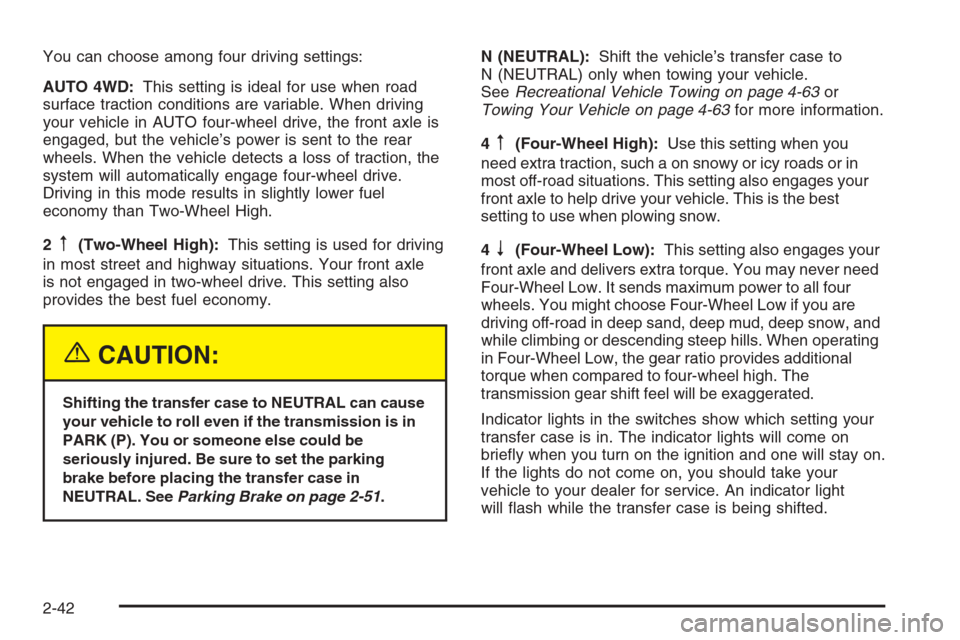
You can choose among four driving settings:
AUTO 4WD:This setting is ideal for use when road
surface traction conditions are variable. When driving
your vehicle in AUTO four-wheel drive, the front axle is
engaged, but the vehicle’s power is sent to the rear
wheels. When the vehicle detects a loss of traction, the
system will automatically engage four-wheel drive.
Driving in this mode results in slightly lower fuel
economy than Two-Wheel High.
2
m(Two-Wheel High):This setting is used for driving
in most street and highway situations. Your front axle
is not engaged in two-wheel drive. This setting also
provides the best fuel economy.
{CAUTION:
Shifting the transfer case to NEUTRAL can cause
your vehicle to roll even if the transmission is in
PARK (P). You or someone else could be
seriously injured. Be sure to set the parking
brake before placing the transfer case in
NEUTRAL. SeeParking Brake on page 2-51.
N (NEUTRAL):Shift the vehicle’s transfer case to
N (NEUTRAL) only when towing your vehicle.
SeeRecreational Vehicle Towing on page 4-63or
Towing Your Vehicle on page 4-63for more information.
4
m(Four-Wheel High):Use this setting when you
need extra traction, such a on snowy or icy roads or in
most off-road situations. This setting also engages your
front axle to help drive your vehicle. This is the best
setting to use when plowing snow.
4
n(Four-Wheel Low):This setting also engages your
front axle and delivers extra torque. You may never need
Four-Wheel Low. It sends maximum power to all four
wheels. You might choose Four-Wheel Low if you are
driving off-road in deep sand, deep mud, deep snow, and
while climbing or descending steep hills. When operating
in Four-Wheel Low, the gear ratio provides additional
torque when compared to four-wheel high. The
transmission gear shift feel will be exaggerated.
Indicator lights in the switches show which setting your
transfer case is in. The indicator lights will come on
brie�y when you turn on the ignition and one will stay on.
If the lights do not come on, you should take your
vehicle to your dealer for service. An indicator light
will �ash while the transfer case is being shifted.
2-42
Page 129 of 580

It will stay on when the shift is complete. If for some
reason the transfer case cannot make a requested shift,
it will return to the last chosen setting.
If the SERVICE 4WD message stays on, you should
take your vehicle to your dealer for service. SeeDIC
Warnings and Messages on page 3-54for further
information.
Shifting into Four-Wheel High or
AUTO 4WD (AUTO Four-Wheel Drive)
Press and release the four-wheel high or AUTO 4WD
switch. This can be done at any speed, except
when shifting from Four-Wheel Low, and the indicator
light will �ash while shifting. It will remain on when
the shift is completed.
Shifting into Two-Wheel High
Press and release the Two-Wheel High switch.
This can be done at any speed, except when shifting
from Four-Wheel Low.
Shifting into Four-Wheel Low
Notice:Shifting the transfer case into four-wheel
low while moving at speeds faster than 3 mph
(5 km/h) may cause premature wear to the transfer
case, and may cause the gears to grind. To avoid
causing premature wear, and grinding the gears, do
not shift the transfer case into four-wheel low while
the vehicle is moving faster than 3 mph (5 km/h).
To shift to Four-Wheel Low, the ignition must be in RUN
and the vehicle must be stopped or moving less than
3 mph (5 km/h) with the transmission in NEUTRAL (N).
The preferred method for shifting into four-wheel low
is to have your vehicle moving 1 to 2 mph (1.6 to
3.2 km/h). Press and release the Four-Wheel Low
switch. You must wait for the Four-Wheel Low indicator
light to stop �ashing and remain on before shifting
your transmission in gear.
Notice:Shifting the transmission into gear before
the Four-Wheel Low indicator light has stopped
�ashing could damage the transfer case. To help
avoid damaging your vehicle, always wait for
the Four-Wheel Low indicator light to stop �ashing
before shifting the transmission into gear.
2-43
Page 133 of 580
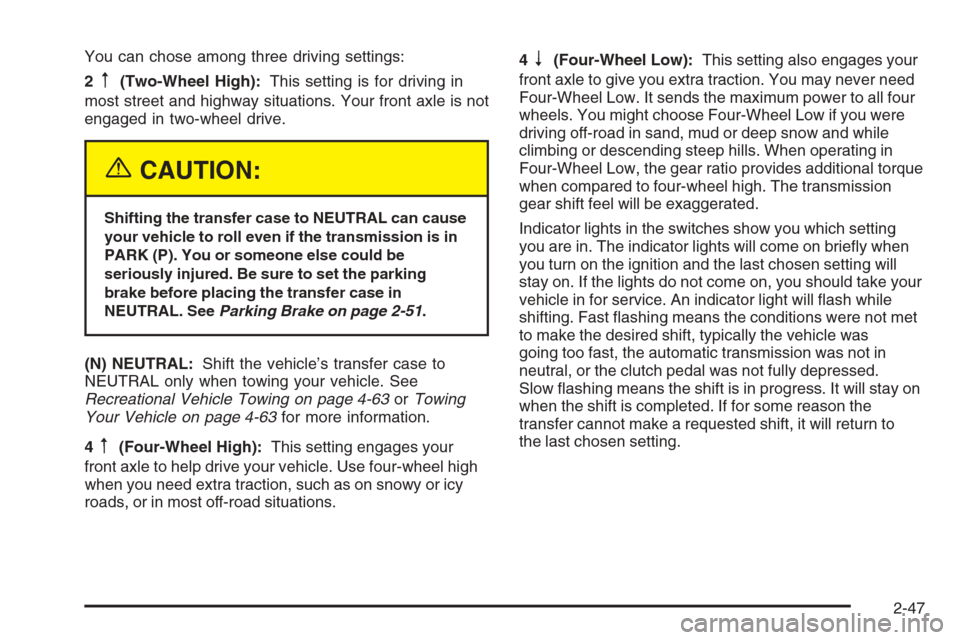
You can chose among three driving settings:
2
m(Two-Wheel High):This setting is for driving in
most street and highway situations. Your front axle is not
engaged in two-wheel drive.
{CAUTION:
Shifting the transfer case to NEUTRAL can cause
your vehicle to roll even if the transmission is in
PARK (P). You or someone else could be
seriously injured. Be sure to set the parking
brake before placing the transfer case in
NEUTRAL. SeeParking Brake on page 2-51.
(N) NEUTRAL:Shift the vehicle’s transfer case to
NEUTRAL only when towing your vehicle. See
Recreational Vehicle Towing on page 4-63orTowing
Your Vehicle on page 4-63for more information.
4
m(Four-Wheel High):This setting engages your
front axle to help drive your vehicle. Use four-wheel high
when you need extra traction, such as on snowy or icy
roads, or in most off-road situations.4
n(Four-Wheel Low):This setting also engages your
front axle to give you extra traction. You may never need
Four-Wheel Low. It sends the maximum power to all four
wheels. You might choose Four-Wheel Low if you were
driving off-road in sand, mud or deep snow and while
climbing or descending steep hills. When operating in
Four-Wheel Low, the gear ratio provides additional torque
when compared to four-wheel high. The transmission
gear shift feel will be exaggerated.
Indicator lights in the switches show you which setting
you are in. The indicator lights will come on brie�y when
you turn on the ignition and the last chosen setting will
stay on. If the lights do not come on, you should take your
vehicle in for service. An indicator light will �ash while
shifting. Fast �ashing means the conditions were not met
to make the desired shift, typically the vehicle was
going too fast, the automatic transmission was not in
neutral, or the clutch pedal was not fully depressed.
Slow �ashing means the shift is in progress. It will stay on
when the shift is completed. If for some reason the
transfer cannot make a requested shift, it will return to
the last chosen setting.
2-47
Page 154 of 580
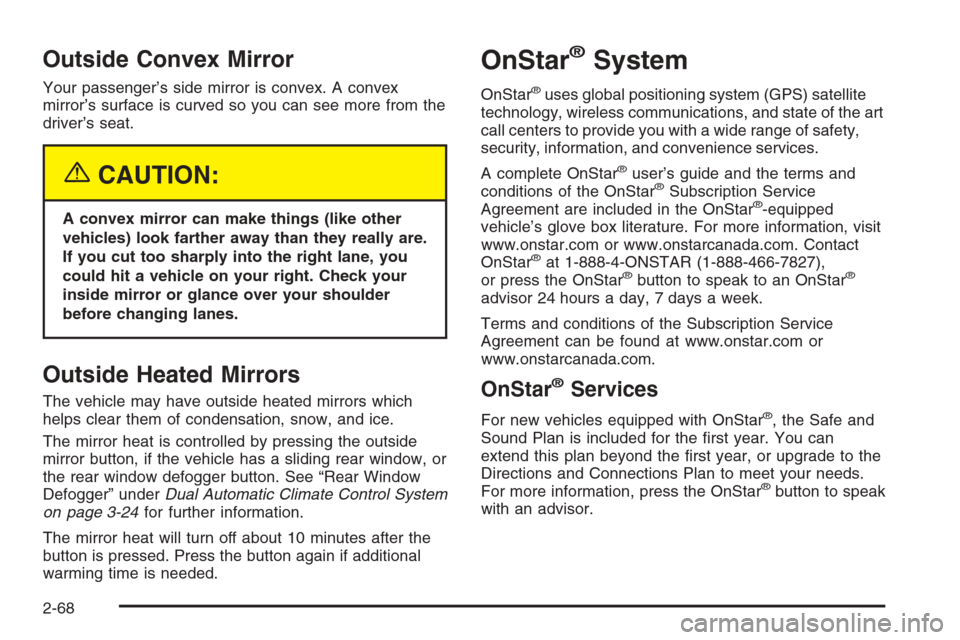
Outside Convex Mirror
Your passenger’s side mirror is convex. A convex
mirror’s surface is curved so you can see more from the
driver’s seat.
{CAUTION:
A convex mirror can make things (like other
vehicles) look farther away than they really are.
If you cut too sharply into the right lane, you
could hit a vehicle on your right. Check your
inside mirror or glance over your shoulder
before changing lanes.
Outside Heated Mirrors
The vehicle may have outside heated mirrors which
helps clear them of condensation, snow, and ice.
The mirror heat is controlled by pressing the outside
mirror button, if the vehicle has a sliding rear window, or
the rear window defogger button. See “Rear Window
Defogger” underDual Automatic Climate Control System
on page 3-24for further information.
The mirror heat will turn off about 10 minutes after the
button is pressed. Press the button again if additional
warming time is needed.
OnStar®System
OnStar®uses global positioning system (GPS) satellite
technology, wireless communications, and state of the art
call centers to provide you with a wide range of safety,
security, information, and convenience services.
A complete OnStar
®user’s guide and the terms and
conditions of the OnStar®Subscription Service
Agreement are included in the OnStar®-equipped
vehicle’s glove box literature. For more information, visit
www.onstar.com or www.onstarcanada.com. Contact
OnStar
®at 1-888-4-ONSTAR (1-888-466-7827),
or press the OnStar®button to speak to an OnStar®
advisor 24 hours a day, 7 days a week.
Terms and conditions of the Subscription Service
Agreement can be found at www.onstar.com or
www.onstarcanada.com.
OnStar®Services
For new vehicles equipped with OnStar®, the Safe and
Sound Plan is included for the �rst year. You can
extend this plan beyond the �rst year, or upgrade to the
Directions and Connections Plan to meet your needs.
For more information, press the OnStar
®button to speak
with an advisor.
2-68
Page 155 of 580
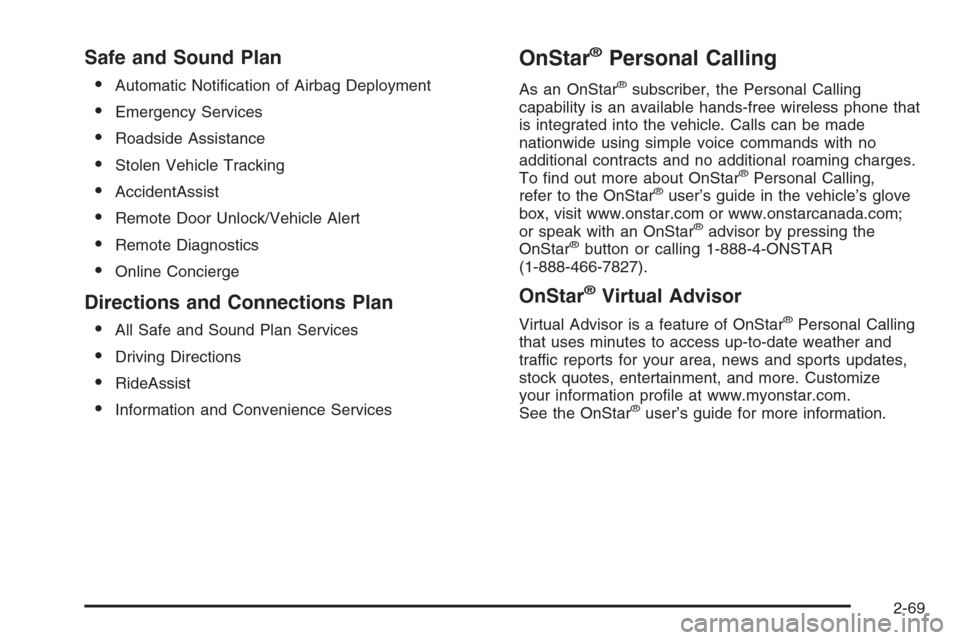
Safe and Sound Plan
Automatic Noti�cation of Airbag Deployment
Emergency Services
Roadside Assistance
Stolen Vehicle Tracking
AccidentAssist
Remote Door Unlock/Vehicle Alert
Remote Diagnostics
Online Concierge
Directions and Connections Plan
All Safe and Sound Plan Services
Driving Directions
RideAssist
Information and Convenience Services
OnStar®Personal Calling
As an OnStar®subscriber, the Personal Calling
capability is an available hands-free wireless phone that
is integrated into the vehicle. Calls can be made
nationwide using simple voice commands with no
additional contracts and no additional roaming charges.
To �nd out more about OnStar
®Personal Calling,
refer to the OnStar®user’s guide in the vehicle’s glove
box, visit www.onstar.com or www.onstarcanada.com;
or speak with an OnStar
®advisor by pressing the
OnStar®button or calling 1-888-4-ONSTAR
(1-888-466-7827).
OnStar®Virtual Advisor
Virtual Advisor is a feature of OnStar®Personal Calling
that uses minutes to access up-to-date weather and
traffic reports for your area, news and sports updates,
stock quotes, entertainment, and more. Customize
your information pro�le at www.myonstar.com.
See the OnStar
®user’s guide for more information.
2-69